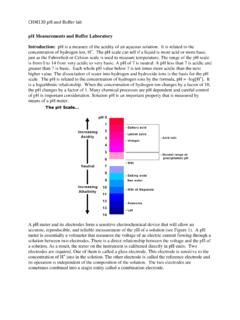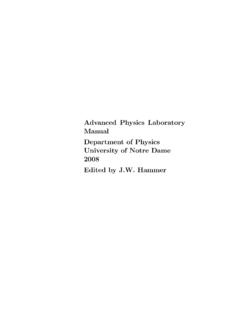Transcription of Laboratory Procedure Manual
1 Laboratory Procedure Manual Analyte: Complete Blood Count Matrix: Whole Blood Method: Complete Blood Count with 5-Part Differential Method No.: Revised: as performed by: Contact: Important Information for Users CDC periodically refines these Laboratory methods. It is the responsibility of the use r to contact the person listed on the title page of each write-up before using the analytical method to find out whether any changes have been made and what revisions, if any, have been incorporated. 7-1. Complete Blood Count using HMX. NHANES 2007-2008. Public Release Data Set Information This document details the Lab Protocol for testing the items listed in the following table: Lab Number Analyte SAS Label White bloo d cell co unt (1000. LBXWBCSI cells/uL). LBXLYPCT Lymphocyte (%). LBXMOPCT Monocyte (%). LBXNEPCT Segmented neutrophils (%). LBXEOPCT Eosinophils (%). LBXBAPCT Basophils (%). Lymphocyte number (1000. LBDLYMNO cells/uL). LBDMONO Monocyte number (1000 cells/uL).
2 Segmented neutrophils number LBDNENO (1000 cells/uL). CBC_E Eosinophils number (1000. LBDEONO cells/uL). LBDBANO Basophils number (1000 cells/uL). LBXRBCSI Red cell count (million cells/uL). LBXHGB Hemoglobin (g/dL). LBXHCT Hematocrit (%). LBXMCVSI Mean cell volume (fL). LBXMCHSI Mean cell hemoglobin (pg). LBXMC MCHC (g/dL). LBXRDW Red cell distribution width (%). LBXPLTSI Platelet count ((1000 cells/uL)). LBXMPSI Mean platelet volume (fL). 2. Complete Blood Count using HMX. NHANES 2007-2008. COMPLETE BLOOD COUNT (CBC). Perform a complete blood count (CBC) in duplicate on all survey participants age 1 and older. Perform the CBC on the Coulter HMX. Run a CBC on the participant's EDTA blood tubes. I. Purpose and Principle of Test CBC Analysis The Coulter method accurately counts and sizes cells by detecting and measuring changes in electrical resistance when a particle (such as a cell) in a conductive liquid passes through a small aperture.
3 Each cell suspended in a conductive liquid (diluent) acts as an insulator. As each cell goes through the aperture, it momentarily increases the resistance of the electrical path between the submerged electrodes on either side of the aperture. This causes a measurable electronic pulse. For counting, the vacuum used to pull the diluted suspension of cells through the aperture must be at a regulated volume. The number of pulses correlates to the number of particles. The height of the electrical pulse is proportional to the cell volume. Differential Analysis As the sample, prepared for differential analysis, streams through the flow cell these three measurements occur simultaneously on each individual white cell to classify it: -Low-frequency current measures volume. -High-frequency current senses cellular internal content through measuring changes in conductivity. -Light from the laser bouncing off the individual WBC cells characterizes cellular surface, shape, and reflectivity.
4 3. Complete Blood Count using HMX. NHANES 2007-2008. The Coulter HMX Hematology Analyzer is a quantitative, automated hematology analyzers and leukocyte differential cell counters for In Vitro Diagnostic use in clinical laboratories. The purpose of the HMX Hematology Analyzer is to separate the normal participant, with all normal system-generated parameters, from the participant who needs additional studies. These studies include further measurements of cell size and cell distribution, biochemical investigation, or any other test that helps diagnose the abnormality. The HMX measures these parameters in whole blood: Cell Parameter Measured Pulse size Reported Units Wavelength Calculation WBC White Blood Cell WBC bath 35 fL n x 103 cells/ L. Count This is the number of leukocytes measured directly, multiplied by the calibration constant, and expressed as n x 103. cells/ L. 4. Complete Blood Count using HMX. NHANES 2007-2008. RBC Red Blood Cell Count RBC bath 36 to 360 fL n x 106 cells/ L.
5 This is the number of erythrocytes measured directly, multiplied by the calibration constant, and expressed as n x 106. cells/ L. Hgb Hemoglobin WBC bath 525 nm g/dL. Concentration Weight (mass) of hemoglobin determined from the degree of absorbance found through photocurrent transmittance is: Hct Hematocrit Computed RBC x MCV/10 % Percent This is the relative volume of packed erythrocytes to whole blood, computed as: Hct (%) = RBC . CV/10. 5. Complete Blood Count using HMX. NHANES 2007-2008. MCV Mean Cell Volume Derived from # x size of RBC/ fL. This is the average RBC histogram Total RBC. volume of individual erythrocytes derived from the RBC. histogram. The system: Multiplies the number of RBCs in each channel by the size of the RBCs in that channel. Adds the products of each channel between 36 fL. and 360 fL. Divides that sum by the total number of RBCs between 36 fL. and 360 fL. Multiplies by a calibration constant and expresses MCV in femtoliters.
6 MCH Mean Cell Hemoglobin Computer Hgb/RBC x 10 pg This is the weight of hemoglobin in the average erythrocyte count, computed as: Hgb/RBC x 10. MCH Mean Cell Hemoglobin Computed Hgb/Hct x 100 g/dL. C Concentration This is the average weight of hemoglobin in a measured dilution, computed as: Hgb/Hct x 100. 6. Complete Blood Count using HMX. NHANES 2007-2008. RDW Red Cell Distribution Derived from CV expressed in % % Percent Width RBC histogram of the RBC size RDW represents the distribution size distribution spread of the erythrocyte population derived from the RBC. histogram. It is the coefficient of variation (CV), expressed in percent, of the RBC. size distribution. Plt Platelet Count RBC bath 2 to 20 fL n x 103 cells/ L. This is the number of thrombocytes derived from the Plt histogram and multiplied by a calibration constant. This number is expressed as: n x 103 cells/ L. MPV Mean Platelet Volume Derived from Plt Mean volume of Plt fL.
7 MPV is the average histogram population under the volume of individual platelets derived from fitted curve x the Plt histogram. It constant represents the mean volume of the Plt population under the fitted Plt curve multiplied by a calibration constant, and expressed in femtoliters. NE% Neutrophil Percent Derived from # cells inside NE % Percent The percentages of scatterplot area/# cells inside leukocytes from each category are derived total cell area x 100. from the scatterplot. NE # Neutrophil Number Absolute number NE%/100 x WBC 103 cells/ L. The absolute numbers Count of leukocytes in each category are computed from the WBC count and the differential percentage parameters. 7. Complete Blood Count using HMX. NHANES 2007-2008. LY% Lymphocyte Percent Derived from # cells inside LY % Percent The percentages of scatterplot area/# cells inside leukocytes from each category are derived total cell area x 100. from the scatterplot. LY# Lymphocyte Number Absolute number Ly%/100 x WBC 103 cells/ L.
8 The absolute numbers Count of leukocytes in each category are computed from the WBC count and the differential percentage parameters. MO% Monocyte Percent Derived from # cells inside MO % Percent The percentages of scatterplot area/# cells inside leukocytes from each category are derived total cell area x 100. from the scatterplot. MO# Monocyte Number Absolute number MO%/100 x WBC 103 cells/ L. The absolute numbers Count of leukocytes in each category are computed from the WBC count and the differential percentage parameters. EO% Eosinophil Percent Derived from # cells inside EO % Percent The percentages of scatterplot area/# cells inside leukocytes from each category are derived total cell area x 100. from the scatterplot. EO# Eosinophil Number Absolute number EO%/100 x WBC 103 cells/ L. The absolute numbers Count of leukocytes in each category are computed from the WBC count and the differential percentage parameters. BA% Basophil Percent Derived from # cells inside BA % Percent The percentages of leukocytes from each scatterplot area/# cells inside category are derived total cell area x 100.
9 From the scatterplot. 8. Complete Blood Count using HMX. NHANES 2007-2008. BA# Basophil Number Absolute number BA%/100 x WBC 103 cells/ L. The absolute numbers Count of leukocytes in each category are computed from the WBC count and the differential percentage parameters *PDW -- Platelet Distribution Width and Pct -- Platelet Crit are NOT for diagnostic use and do not print. Coulter uses the value for PDW as an internal check on the reported platelet parameters, Pct and MPV. Methodology: The methods used to derive CBC parameters are based on the Coulter method of counting and sizing, in combination with an automatic diluting and mixing device for sample processing, and a single beam photometer for hemoglobinometry. The WBC differential uses VCS. technology. Analysis and classification of WBCs use three simultaneous measurements of individual cell volume (V), high frequency conductivity (C), and laser light scatter (S). The scattergram plots the cells based upon the measurements of these three parameters.
10 A. Status Line The status line at the bottom of your screen indicates the current operating status of the HMX Hematology Analyzer. II. Special Safety Precautions All specimens may be potentially positive for infectious agents including HIV and the hepatitis B. and C viruses. Observe universal precautions. It is mandatory to wear gloves and lab coat when handling all human blood products and Coulter controls. Wear safety glasses whenever operating the instrument in SECONDARY mode. Dispose of all biological samples in a biohazard container and wipe down all work surfaces with 10% bleach solution at the end of each session. The mobile examination center (MEC) Working Safely with Hazardous Chemicals Manual contains all Coulter material safety data sheets (MSDS). 9. Complete Blood Count using HMX. NHANES 2007-2008. III. Computerization: Integrated Survey and Information System (ISIS). The HMX Data Management System (DMS) transmits individual SP results to the MEC.















